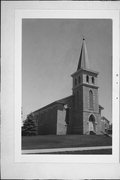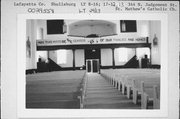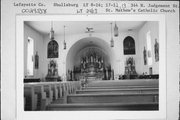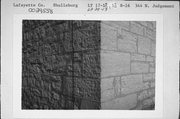| Additional Information: | This church structure with Greek Revival characterisitcs of a sloping roof, stone quoins, and cornice returns is built of coursed limestone from the local Rennick Quarry.(A) The original building was 55 feet by 110 feet, built at a cost of $15,000.(B) Flat window lintels of stone from the Emerson Mill Quarry decorate the plain side facades.(A) Pointed Gothic arched door frame and steeple openings accent the front facade in contrast to the simple rectangular windows of the side elevations. The round window openings in the upper steeple decorated by semi-circular window bands add further variety to the surface.
A large group of Irish Catholics settled near the present village of Shullsburg beginning in the 1830's. The Irish settlements in sections 2 and 3 just North of the village were called the Irish Diggings and Dublin.(F)
Father Samuel Mazzuchelli was an Italian priest who went to the western frontier to minister to the Indians at Green Bay in the 1820's. Attracted to the lead region in the mid-1830's, Mazzuchelli moved to Galena. While he was stationed in Galena, Mazzuchelli made several trips into the Wisconsin lead fields to Gratiot's Grove, Shullsburg, New Diggings, and other lead mining communities. At Gratiot's Grove and Shullsburg he held services in miner's cabins.(C)
In 1841, a frame church was erected at the site of the present stone church.(C) The frame church was designed by Mazzuchelli.(F) The land on which the church is located was donated by John Ryan and John Roberts. Mazzuchelli laid out the streets in the Northeast section and named the streets - Peach, Truth, Friendship, etc.(B,C) As the congregation grew, a small annex was built on the side to accommodate overflow on Sunday and to double as the parochial school during the week.(F) After the church was built and established another priest was called to serve the church.
Beginning in 1852, the congregation decided to build a larger church. For the next 10 years, 1852-62, the building was erected as money and labor became available.
Part of St. Matthew's Mission has been to run a parochial school. The earliest record of a school was in 1866, when three Sisters of the Dominican Order at Sinsinawa Mound were sent to establish St. Rose's School at Shullsburg. In 1895, the school was discontinued when the mines closed. The number of families was reduced from 300 to 65.(D) A new shcool was built in 1917-18. The Sisters of Mercy from Janesville staffed the school. The school was closed in 1967.
The Catholic Church has played a pivotal role in the religious and educational development of the village. A large Irish Catholic population still live in the area.
St. Matthew's Church is historically significant first for its association with Father Samuel Mazzuchelli, a pioneer priest, who was the leading force behind the establishment of the Roman Catholic Church in the Southwestern Wisconsin lead region. Mazzuchelli was also an architect and designed many churches and public buildings. As well, the Catholic Church was one of the first religious organizations in Shullsburg and has remained a dominant institution of the village.
The sextagonal steeple that rises to a height of 135 feet (with a 12 ft. high cross) has a denticulated cornice at its base.(D) The steeple was built in 1908 in place of the original steeple with a dome-shaped roof, which was struck by lightning and burned in 1907.(E) Stained glass windows were added in 1907.(F) The interior decoration has been greatly altered over the years.
This church is architecturally significant as a landmark because it is a substantial structure that played an important part in the community of Shullsburg. In addition, it is an example of the work of Fr. Samuel Mazzuchelli, a prominent priest/architect in early Wisconsin history.
|
|---|
| Bibliographic References: | WISCONSIN STATE JOURNAL 7/24/1994.
A. St. Matthew's "Centennial History," 1835-1935, p. 9.
B. Butterfield, "History of Lafayette Co., 1881, p. 573.
C. Ibid, p. 580-581.
D. "St. Matthew's Centennial History," p. 11, 12.
E. Ibid., p. 10.
F. Ibid., p. 6-8.
G. Butterfield, G., p. 571.
|
|---|




